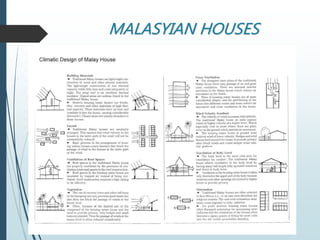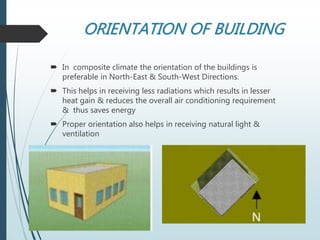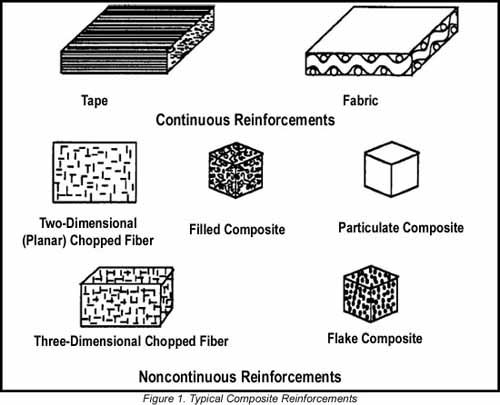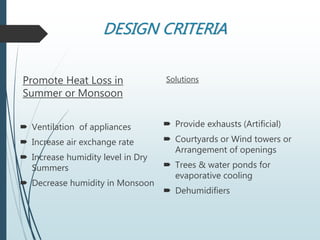Passive solar systems basic rules-1. Climate responsive architecture takes into consideration seasonality the direction of the sun sun path and solar position natural shade provided by the surrounding topography environmental factors such as wind rainfall humidity and climate data temperature historical weather patterns etc to design comfortable and energy-efficient homes.
With respect to building design parameters such as temperature ai r movement solar radiation and humidity.

. The environmental social and economic bonding holds together the stakeholders or the urban population. The scope of work for projects may include a copy of the completed RRVA for reference or the Design Consultant may request a copy. Moreover there currently exists a lack of in-depth research on the influence of design strategies on the energy consumption of high-rise buildings in tropical climate Raji et al 2016.
A 90-degree day is rare indeed. ORIENTATION OF BUILDING In composite climate the orientation of the buildings is preferable in North-East South-West Directions. It takes up large amount of heat in evaporation and causes significant cooling.
There two main reasons. The key of design take an advantage of local climate microclimate for human comfort. So composite climate receives3 distinct seasons summers monsoons and winters and the conditions vary in each ofthese seasons which is what the problematic causes.
This communication presents design considerations and thermal performance of a hostel building using passive techniques for a composite climatic condition of Delhi India. Warming a home in Wisconsin from 25 degrees to 70 degrees means increasing the temperature by 45 degrees. Detailing building fenestration design and construction details to promote shading heat loss and insulation.
Orientation of the future buildings footprint entrances exits glazing interior spaces etc are prudently arranged and manipulated to create the most aesthetically pleasing efficient and economical plan for the. And the sky conditions are againvariable which because it experiences all the 3 seasons. There are certain design considerations for composite region buildings which should resist heat gain in summer and resist heat loss in winter.
31 Light Shelves 32 Curtain Wall 33 Low-E Double-Glazed Glass 3. However the underlying principle remains the same maximising amount of solar radiation in winter and minimizing the amount in summers. Hot-dry early summer warm-humid late summer monsoon period and cold-dry period in winter.
And 300 PM during the. Design strategies for cold and cloudy climate. The external walls should be so planned that they shade each other.
Considerations for buildings to become comfortable include realisation of an open barrier between the indoor and outdoor climate make use of solar and natural ventilation strategies and allowance for human intervention in climate control to satisfy subjective needs Fountain et al 1996. Location of water bodies. CLIMATE RESPONSIVE DESIGN STRATEGIES IN COMPOSITE CLIMATE In passive solar energy mechanical means are not employed to utilize solar energy.
Double walls with insulation in between are a suitable solution The size of the windows on the east and west sides should be minimized in order to reduce heat gain. Larger building dimensions should face north south. Design for climate means that a home is designed or modified to.
First there are generally fewer degrees of difference between indoor and outdoor conditions in warmer climates. The buildings south face should receive sunlight between the hours of 900 AM. CLIMATIC CONSIDERATIONS PROJECTIONS.
Now the physiological objectivefor composite climate becomes very difficult. Building designs vary according to context of its location and climate. Ensure adequate shading on the south side to cut off direct solar radiation during summers and permit winter sun.
The air-conditioning and lighting consumption can be reduced by in- corporating climate-responsive features in the design. Mahdavi and Kumar 1996. Jalis on the outer facade of the building helps in cooling shading and ventialtion.
Often referred to as climatology it is to study the various climate-based influencing factors on our living conditions particularly under the heads of seasonality sunlight rain wind and humidity of the target construction site for maximal dialogue between the structure and its surroundings in particular the climate. The passive design strategies for composite climate and also presents the various methods of passive cooling techniques. The micro climate of each zone is also assessed so.
The Seattle climate doesnt change much throughout the year. Up to 24 cash back This rate could be cut to almost zero in new housing through sound climate responsive design and indeed should be our aspirational goal. This helps in receiving less radiations which results in lesser heat gain reduces the overall air conditioning requirement thus saves energy Proper orientation also helps in receiving natural light ventilation.
The place experiences three definite seasons. If a home is built correctly you can orient a building to promote natural ventilation. In Florida cooling a building from 95 degrees to 75 degrees requires only 20 degrees of change.
In predominantly hot regions buildings should be ideally oriented to minimize solar gains the reverse is applicable for cold regions. Water is a good modifier of micro-climate. The 40 of household energy used for heating and cooling to achieve thermal comfort could be cut to almost zero in new housing through sound climate responsive design.
The design should also consider projected changes to. Orient the buildings with longer axes in the east-west direction. Large projecting eaves and wide verandahs are needed in composite climate as out-door living areas to reduce sky glare keep out the rain and provide shades.
The average low for the year comes in December or January and usually bottoms out around 37 degrees. The actual comfort conditions achieved will be contextual and depend on the building topology and building design specifications. In composite climate the envelope should be designed so that it remains shaded for the greater part of the day.
Warm and humid climate 3. With reference to the same the prompted design considerations vary. The climate resilience design considerations for each of those linked sections as well as additional climate resilience resources by section are included in this document for easy reference.
CLIMATIC CONSIDERATIONS JALIS. The building should be elongated on an east-west axis. A country is divided into five major climatic zones 1.
In the summer months we rarely move above the 80-degree mark. Suit the climate it is built in keep the occupants thermally comfortable that is they do not feel too hot or too cold use minimal heating or cooling. In the creative process of building design a great deal of consideration is given to the physical landscape of a development.

Composite Resin Composition Surface Resin

Design Of A Sustainable Residence In Composite Climate Of India





0 comments
Post a Comment